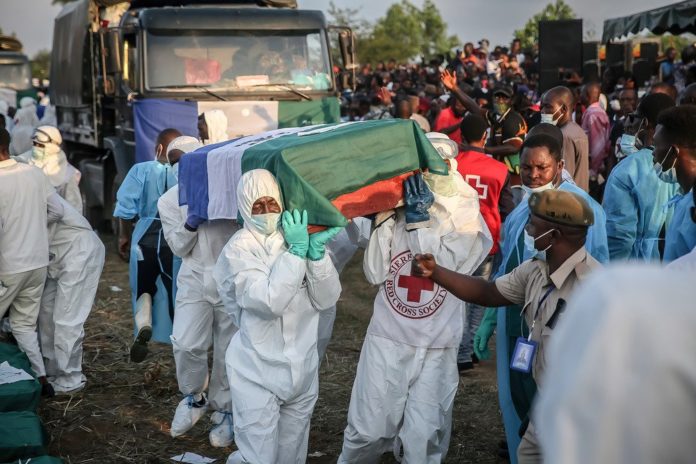By Amin Kef Sesay
A fuel tanker explosion that killed more than 130 people recently in the Sierra Leonean capital, Freetown, has raised renewed questions over disaster preparedness in African cities and the urgent lessons that need to be learnt.
The 5 November explosion followed a road accident between the tanker and a lorry at a busy road junction in the city’s eastern district of Wellington, a densely populated semi-industrial hub. The resultant fireball destroyed homes, shops, and scores of vehicles and motorbikes – depriving countless people of their livelihoods.
It is far from the first large-scale urban disaster to befall Sierra Leone: The country sits in 47th place out of 181 nations on the World Risk Index 2021. A massive landslide in 2017 killed at least 1,100 people – buried in the same cemetery as the tanker blast victims.
President Julius Maada Bio has promised to set up a task force to investigate the latest tragedy and to make recommendations for much-needed change. The following provides an insight into how the explosion has exposed the gaps in Sierra Leone’s disaster readiness.
The Social Construction of Risk: The incident points to how people’s risk perception – and needs – can exacerbate vulnerability. Rather than treating the fuel gushing from the damaged tanker prior to the explosion as a hazard, Wellington’s residents tried to collect it as a windfall, underlining how poverty can drive dangerous behaviour.
Mitigating that risk calls for urgent and sustained public education on technological hazards of this nature, and on what should be the appropriate response in such circumstances.
Readiness of Medical Emergency Services: The volume of casualties seeking treatment – more than 100 severely burned victims – exposed a critical weakness in the preparedness of medical services.
Freetown’s healthcare system is underfunded, and hasn’t fully recovered from the 2014-2015 Ebola epidemic, which killed over 220 doctors, nurses, and other healthcare providers.
The city’s main referral hospital, Connaught, was overwhelmed with the influx of injured people from the fire disaster. Scarce medical supplies and limited bed capacity prompted the intervention of the World Health Organization – but there were delays in the time-sensitive treatment required by severe burn victims.
Rapid Disaster Coordination: There was a critical time lag of about 40 minutes between the time when the accident occurred and the subsequent explosion.
The scale of the disaster could have been minimized if a nearby police post had acted swiftly to cordon off the accident scene, divert traffic, and liaise with the fire service to deal with the highly flammable fuel discharge.
Road Safety: Road accidents are one of the main urban risks people face. Despite this, vehicle road safety testing is a rarity in Freetown, and the roadworthiness of large trucks in particular is questionable.
Anecdotal evidence suggests the brakes failed on a lorry carrying granite that then rammed into the fuel tanker, causing the disaster. Enforcement of mandatory vehicle safety standards would make accidents less likely.
Regulatory Push: Existing regulatory frameworks need to be revamped, and road safety is one glaring area. Road traffic deaths in Africa are the highest in the world.
This goes beyond the remit of the newly established National Disaster Management Agency (NDMA) and requires a carefully coordinated approach with other bodies, including the Petroleum Regulatory Agency, the Sierra Leone Road Safety Authority, and the Motor Drivers and General Workers Union.
Cascading Effects of Disasters: The full extent of the tragedy is not just the statistics on fatalities and injuries. The initial assessment reported the destruction of homes, shops, and market stalls, and more than 60 cars and motorbikes. The bulk of the loss is linked to income-generation activities and will have a lasting impact on the economic fabric of the area.
Talk of “recovery” should therefore be long-term and holistic, encompassing healthcare but also livelihood and social support for survivors and the dependents of the victims.
Proactive Measures to Minimize Future Risk: There is significant scope to improve emergency response mechanisms, including how disaster information is shared and acted upon.
This will be a test case for the NDMA as it aims to decentralize disaster risk reduction efforts, improve early warning and risk communication systems, and build institutional capacity.
Closing the Gaps:The gaps in the NDMA’s capacity, both human and infrastructural, must be critically assessed. The same goes for its support institutions, which include the security forces – key first responders in such emergencies.
The performance of the fire service also needs to be reviewed. For instance, previous major blazes in Freetown have highlighted how equipment limitations can hinder the speed of the response.
This tragedy is a wake-up call to ensure that disaster risk management budgets are protected, accessible, and deployed efficiently throughout the country to fill capacity and infrastructure deficits.
Public Awareness: Greater recognition should be given to the resourcefulness of community-based organizations and to their awareness-raising capabilities. These groups exist even in informal settlements and they can be drafted in to help with the design and delivery of appropriate risk messaging.






